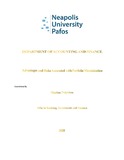| dc.description.abstract | The main purpose of the underlying thesis was to put in practice Markowitz Modern Theory in
the Nasdaq 100 Index using the original Capital Asset Pricing Model (CAPM) as well as finding
the advantages and risks associated with Portfolio Optimization. We employed monthly data
from January 2010 to January 2020, 12 out of 103 stocks comprised in the NASDAQ 100 Index,
and the 3-month US T-Bill rate. We firstly obtained the Expected Rate of Return for each stock
by estimating a simple CAPM. Apple Inc (AAPL), Texas Instruments Inc (TXN), Microchip
Technology Inc (MCHP), VeriSign Inc (VRSN), Western Digital Corp (WDC), Mondelez
International Inc (MDLZ), Tesla Inc (TSLA), Starbucks Corp (SBUX), Amgen Inc (AMGN),
United Airlines Holdings Inc (UAL), Fiserv Inc (FISV), and Amazon.com, Inc. (AMZN). Then,
the values found were weighted to find the Minimum Variance Portfolio. We found that WDC
had the highest expected return (24.76%), while TSLA had the highest standard deviation
(15.26%). AMZN and AAPL on the other hand had the second and third highest expected return
respectively (21.89% and 20.08%) with a relatively low enough risk (7.89% and 7.76%)
respectively. Nevertheless, our analysis reveals that stock series with the high expected return
(AMZN, APPL WDC, TXN) and stock series with relatively high standard deviation (TSLA)
were given low to zero weights within the Minimum Variance Portfolio, while stock series with
relatively medium to high returns and relatively low standard deviation were given higher
proportion. FISV SBUX, and AMGN had expected returns of 11.88%, 9.27%, 11.17%
respectively as well as standard deviation of 4.46%, 5.63%, 6.13% respectively. Specifically, our
Minimum Variance Portfolio results suggest that we shall invest the 34.9% of our wealth to
FISV, the 17.55% to SBUX, and the 18.85% to AMGN and 0.00% to AMZN, TXN and WDC.
Finally, this thesis provides recommendations to investors. | en_UK |


